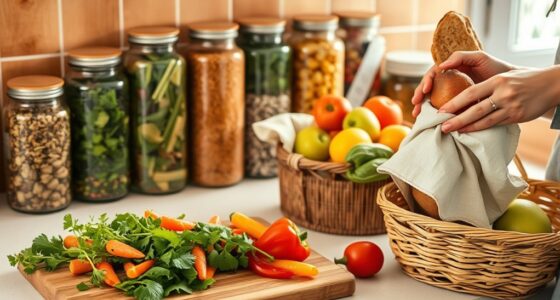Composting kitchen scraps transforms waste into rich soil and reduces landfill impact. You’ll want to include vegetable and fruit peels, coffee grounds, and eggshells, but avoid meat, dairy, and greasy foods to prevent pests and odors. Layer greens with browns like leaves or paper, keep moisture balanced, and turn the pile regularly for aeration. Proper management results in nutrient-dense compost. Keep exploring how to set up and maintain your compost for best results.
Key Takeaways
- Compost fruit, vegetable scraps, coffee grounds, and eggshells while avoiding dairy, meat, fats, and cooked foods.
- Use a balanced mix of greens (kitchen scraps) and browns (leaves, paper) for optimal decomposition.
- Layer materials properly, start with coarse browns, and turn the pile regularly for aeration.
- Maintain moisture like a damp sponge and ensure good airflow to promote microbial activity.
- Troubleshoot issues like odors or pests by adjusting materials, turning the compost, and balancing greens and browns.
Understanding the Benefits of Composting Kitchen Waste
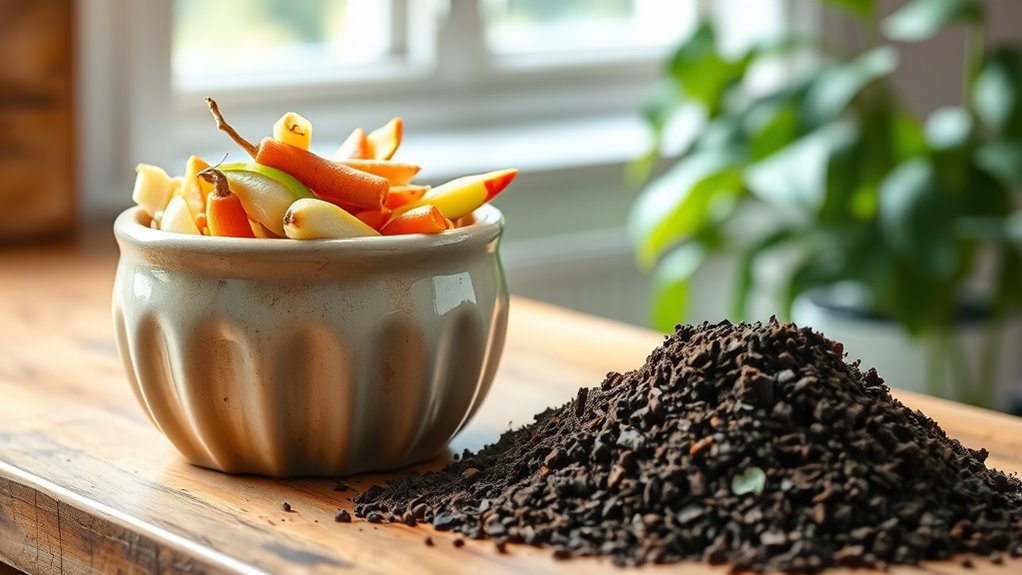
Composting kitchen waste offers numerous benefits that can positively impact both your environment and your wallet. By composting, you support nutrient cycling, returning valuable organic material to the soil naturally. This process reduces reliance on chemical fertilizers, making your gardening eco-friendly practices more sustainable. When you turn kitchen scraps into compost, you minimize waste sent to landfills, decreasing methane emissions and your carbon footprint. Plus, you save money by producing your own nutrient-rich soil, which helps your plants thrive without extra costs. Composting also encourages a healthier ecosystem around your home, promoting beneficial microbes and insects. Proper aeration and moisture levels are essential to maintain high-quality compost, ensuring the best results for your garden. Incorporating appropriate tools and techniques can further optimize the composting process. Additionally, understanding the top composting methods can help you choose the best approach for your specific needs. Using advanced composting strategies, you can further enhance decomposition rates and nutrient content. Overall, embracing kitchen waste composting is a simple step towards a greener lifestyle that benefits your garden, your wallet, and the planet.
What You Can and Cannot Compost From Your Kitchen
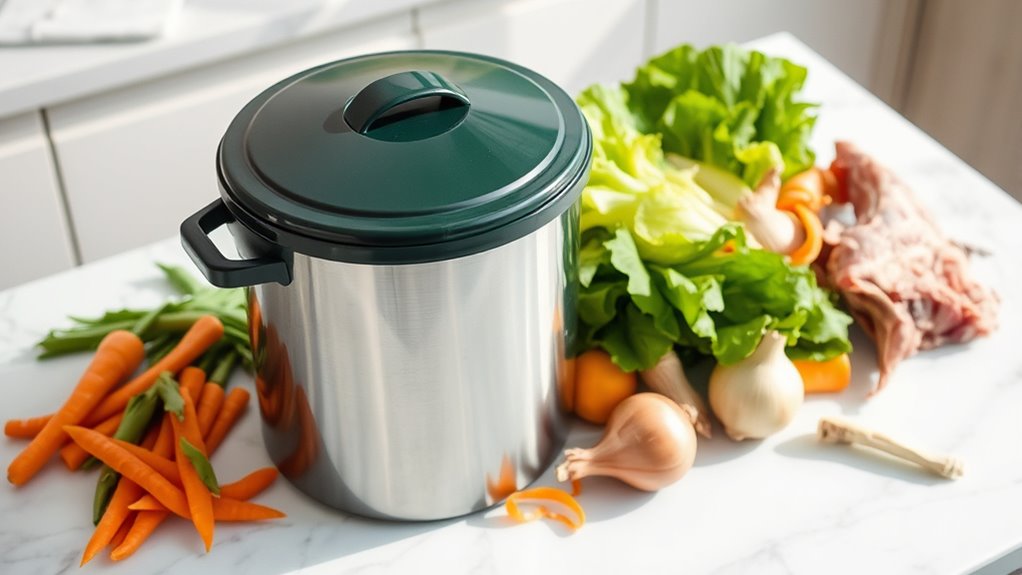
Knowing what to include and what to avoid in your kitchen compost is crucial for maintaining a healthy, efficient compost pile. While food waste is a key component, there are some common composting myths to watch out for. You can compost fruit and vegetable scraps, coffee grounds, eggshells, and tea bags. However, avoid adding dairy products, fats, or cooked food, as these can attract pests and create odors. Meat scraps and greasy foods should never go in your compost. These items can introduce bacteria and disrupt the composting process. Remember, keeping a balanced mix of greens and browns is essential for compost health. Being aware of what you can and cannot compost helps prevent issues and ensures your kitchen scraps turn into rich compost efficiently. Incorporating layer textures and colors from interior decor principles can also help create a more inviting compost area that encourages regular maintenance. Ensuring proper aeration and moisture levels is essential for a thriving compost environment that decomposes efficiently, particularly when managing diverse kitchen scraps and organic waste. Additionally, understanding the importance of composting balance can help optimize decomposition and reduce odor issues.
Setting Up Your Composting Space

Setting up your composting space is the first step toward turning kitchen scraps into rich soil. Choose a spot for your compost bin that’s easily accessible but away from your home’s living areas to minimize odors. Proper compost bin placement helps you monitor and maintain your compost easily. Consider placing it on a well-drained surface to prevent excess moisture. To control odors, incorporate odor control strategies like adding carbon-rich materials or using a bin with a tight-fitting lid. Make certain good airflow by aerating your compost regularly. Keep the bin covered to prevent pests and reduce smells. Clear organization and thoughtful placement will make composting more manageable and enjoyable, helping you stay committed to recycling kitchen scraps and creating nutrient-rich soil for your garden. Using self watering plant pots can also help maintain soil moisture levels during composting or gardening activities. Additionally, understanding local grocery store hours can help you plan your shopping trips for necessary composting supplies. Incorporating nutrient cycling principles into your composting routine enhances soil fertility and supports sustainable gardening practices. Proper maintenance of your compost bin is essential to prevent issues like odors and pests, ensuring a successful composting experience.
The Right Balance of Green and Brown Materials

Getting the right mix of green and brown materials is key to successful composting. You should aim for about one part green to three parts brown by volume, using greens like vegetable scraps and fresh grass clippings, and browns such as leaves, paper, or cardboard. Balancing these materials guarantees your compost breaks down efficiently and stays odor-free. Incorporating fabric decorating markers can be a fun way to personalize compost bins or labels for your composting area. Additionally, understanding the Law of Attraction can help you stay motivated and positive during your composting journey, reinforcing your commitment to a sustainable lifestyle. Paying attention to the celestial influences on personal traits can also inspire a deeper connection with natural cycles and growth.
Green Material Ratios
Achieving the right balance of green and brown materials is essential for successful composting. Too many greens can cause odors and attract pests, while too many browns slow decomposition. For worm composting and general composting, aim for a ratio of roughly 1 part green to 3 parts brown. This helps maintain proper airflow and minimizes composting odors. Monitor moisture levels and aerate regularly to keep the environment healthy for worms. Incorporate green materials like fruit and vegetable scraps in moderation, ensuring they don’t overwhelm the browns. Remember, proper ratios promote efficient decomposition and prevent unpleasant smells, making your composting process smoother and more effective. Additionally, understanding the types of compostable materials can help optimize the green-to-brown balance. Keeping in mind the mindfulness of your composting environment can also contribute to more sustainable and effective composting practices.
Brown Material Examples
Brown materials provide the carbon-rich foundation needed for effective composting. Common examples include dried leaves, straw, shredded paper, and cardboard. You can also use natural fibers like burlap sacks or old cotton fabrics. These materials help balance green scraps, ensuring proper airflow and moisture retention. Be cautious of composting myths—some believe you need only green materials or that brown items slow decomposition. In reality, a mix of brown and green materials creates an ideal environment for microbes to break down waste efficiently. Using a variety of natural fibers improves compost quality and reduces waste. Always aim for a proper balance: about three parts brown to one part green. This mixture promotes faster composting and produces rich, fertile soil. Incorporating carbon sources like wood chips or nut shells can further enhance the composting process and improve soil nutrients. Additionally, maintaining the right carbon-to-nitrogen ratio is crucial for efficient decomposition and healthy compost. Proper moisture levels are also essential to keep microbes active and the process moving smoothly.
How to Properly Layer and Mix Your Compost
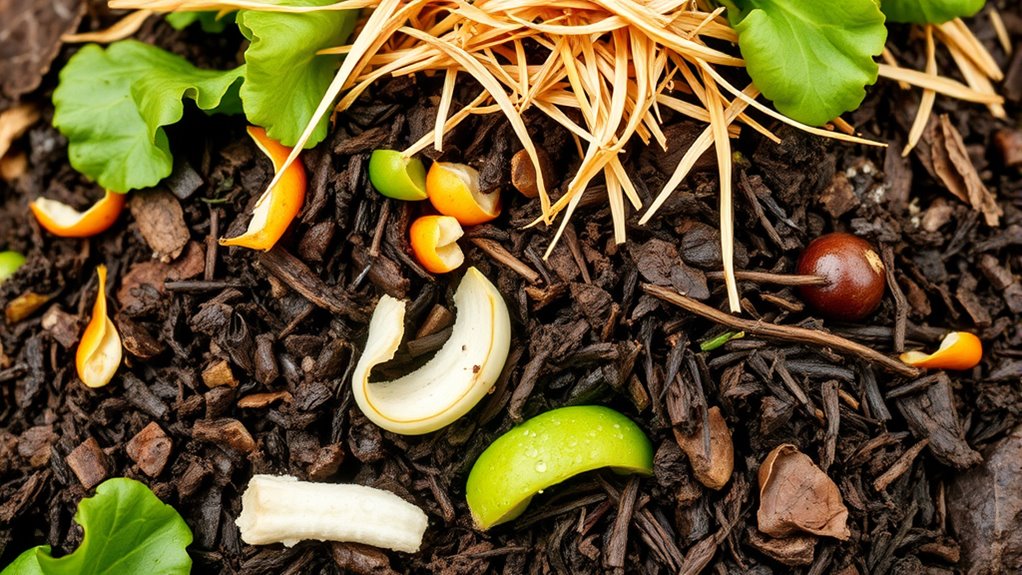
To create an effective compost, you need to properly layer and mix your materials. Using proper layering techniques ensures good airflow and decomposition. Begin with a base of coarse brown materials like sticks or straw. Alternate layers of green kitchen scraps with browns, aiming for a balance to prevent odors. When mixing, turn the pile regularly with a pitchfork or compost turner to aerate and distribute moisture. This promotes even decomposition and prevents compaction. Incorporating composting techniques can further enhance the process and help achieve better results.
Maintaining Your Compost Pile for Optimal Results
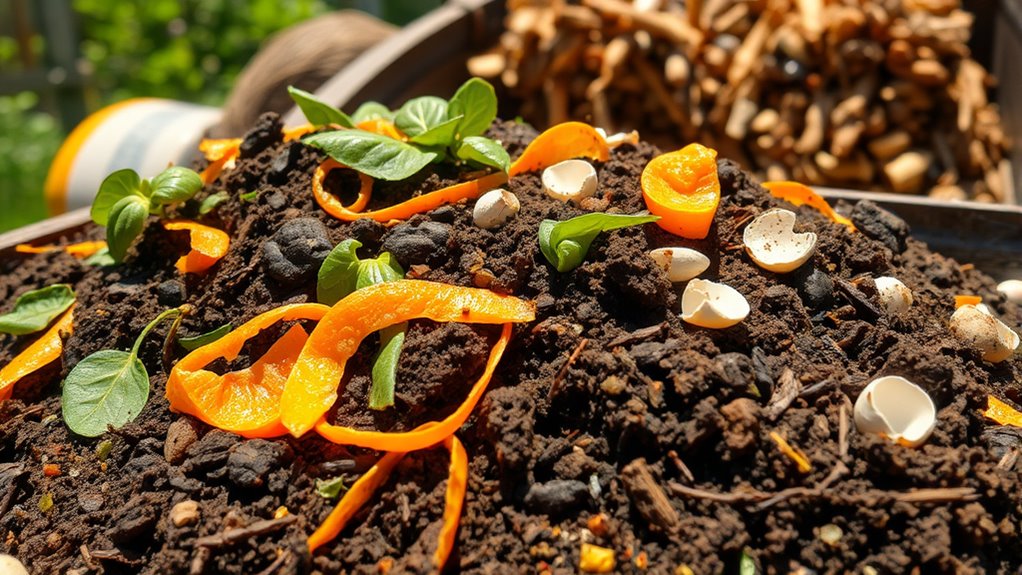
Maintaining your compost pile is essential to guarantee it breaks down efficiently and produces rich, usable soil. To do this, ensure proper aeration and moisture levels by managing compost bin ventilation. Good airflow prevents odors and encourages beneficial microbes and worm composting activity. Regularly turn or mix your compost to distribute heat and oxygen evenly. Keep an eye on moisture; it should feel like a damp sponge. Adding brown materials helps balance nitrogen and carbon levels.
| Tip | Why it matters |
|---|---|
| Improve ventilation | Promotes oxygen flow, reduces odors |
| Use worms for composting | Accelerates decomposition and enriches soil |
| Turn regularly | Maintains consistent breakdown, prevents matting |
| Monitor moisture | Keeps microbes active, prevents drying out |
Troubleshooting Common Composting Issues
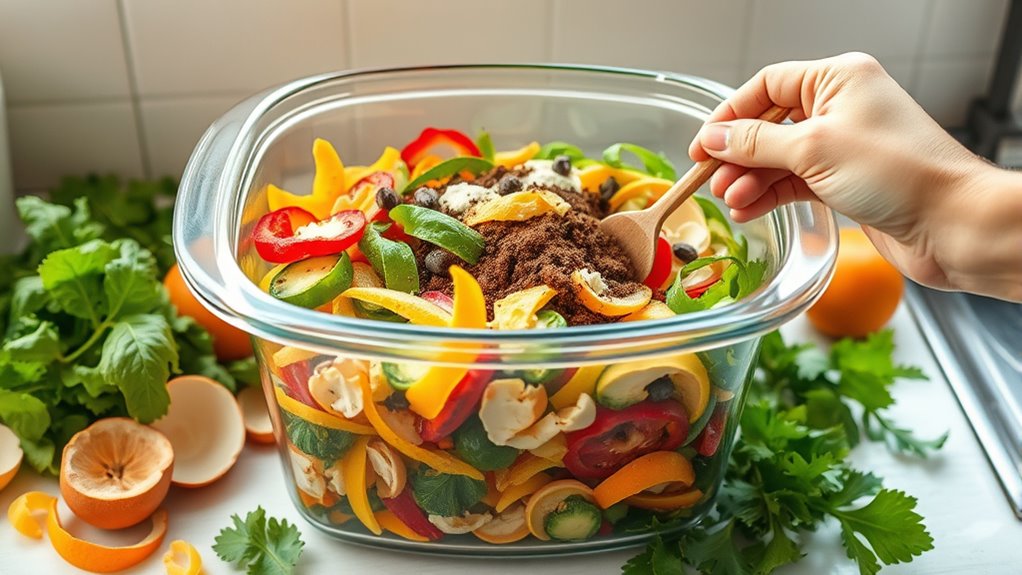
Despite careful management, composting can sometimes face common issues like foul odors, slow decomposition, or soggy piles. To troubleshoot, focus on pest prevention by avoiding meat or dairy scraps that attract pests. Proper moisture control is essential—your pile should be moist but not soaked. If odors develop, turn the compost regularly to aerate and reduce excess moisture. For soggy piles, add dry materials like straw or shredded paper to restore balance. Additionally, check for:
- Excess nitrogen-rich materials
- Insufficient aeration
- Overwatering or poor drainage
- Lack of browns to balance greens
Addressing these issues promptly keeps your compost healthy, odor-free, and pest-resistant. Consistent management guarantees a faster, more efficient composting process.
Using Your Finished Compost in the Garden
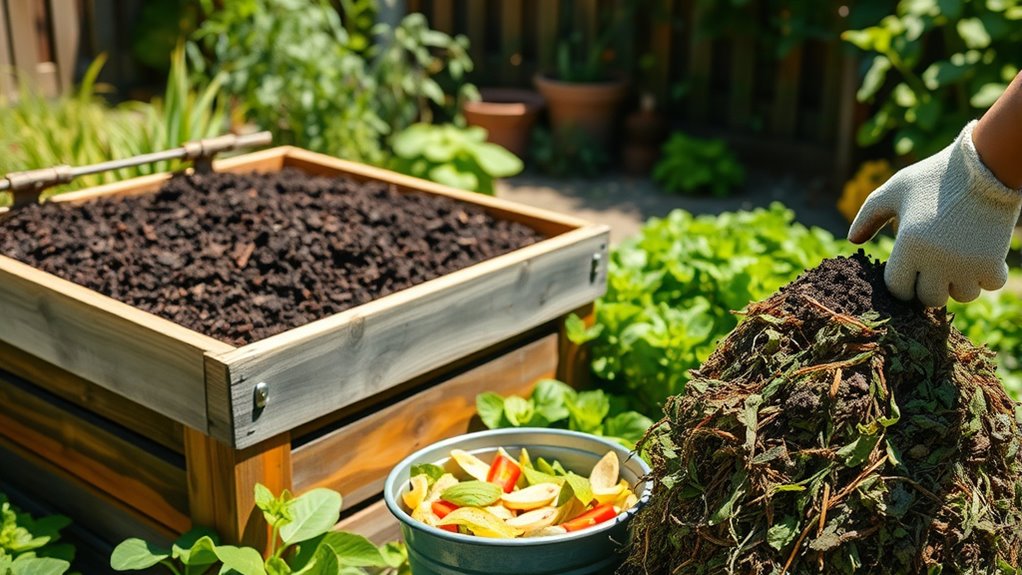
Once your compost has fully broken down into rich, dark soil, it’s ready to give your garden beds a boost. Spread it evenly around your plants, working it into the topsoil to improve soil structure and nutrient content. You can also mix compost into potting mixes for container gardening. To maximize benefits, make compost tea by steeping finished compost in water for 24-48 hours, then straining and watering your plants with it. This liquid fertilizer delivers nutrients directly to roots, promoting healthy growth. Regularly applying compost and compost tea helps maintain soil fertility, suppresses pests, and encourages beneficial microbes. Incorporate your finished compost thoughtfully, and your garden will thrive with vibrant, productive plants.
Frequently Asked Questions
How Long Does It Take for Kitchen Scraps to Turn Into Compost?
The decomposition timeline for kitchen scraps varies depending on factors like temperature, moisture, and aeration, but typically, it takes about 3 to 6 months for them to turn into rich compost. During this composting duration, you’ll notice scraps breaking down and turning dark and crumbly. To speed up the process, turn the pile regularly and keep it moist. Patience is key; your efforts will result in nutrient-rich compost for your garden.
Can I Compost Cooked Food and Dairy Products?
You can compost cooked food and dairy, but you should follow cooked food safety and dairy composting tips to prevent issues. Cooked foods and dairy can attract pests, so balance them with browns like leaves or paper. Keep your compost moist and turn it regularly. Use a sealed bin if possible, and avoid adding large quantities at once. Proper management ensures safe, effective composting of these items.
Is It Necessary to Turn or Aerate My Compost Regularly?
You should turn or aerate your compost regularly to maintain proper oxygen flow. This process helps break down materials efficiently and prevents odors. Regular aeration also reduces composter maintenance by avoiding compaction and ensuring beneficial microbes stay active. By staying consistent with turning, you promote healthy decomposition, resulting in rich, usable compost faster. Remember, good oxygen flow is key to a successful and low-maintenance composting system.
What Are the Signs That My Compost Is Ready to Use?
When your compost is ready, you’ll notice compost maturity through a dark, crumbly texture and earthy smell. Nutrient indicators like a balanced carbon-to-nitrogen ratio and consistent temperature suggest it’s mature. You might also see little to no recognizable kitchen scraps. If it feels cool or has a foul odor, it’s not ready yet. Use your compost when it looks, smells, and feels like rich soil to make sure it benefits your garden.
How Do I Prevent Pests From Accessing My Compost Bin?
Wildlife intrusion can turn your compost pile into a pest magnet, but you can easily prevent this. Use pest-resistant bins with tight-fitting lids and avoid adding meat or dairy, which attract pests. Bury food scraps deep in the pile and turn it regularly to discourage critters. Keep the area clean and secure, and consider using natural repellents. These steps protect your compost and keep pests at bay effectively.
Conclusion
As you become more confident in composting, you’ll start noticing how your garden flourishes just as your kitchen scraps dwindle. It’s almost like the garden and your waste find harmony by chance, turning what once was trash into treasure. With a little patience and care, you’ll enjoy lush plants and fewer waste bins, all thanks to your new composting routine. Who knew that a simple habit could create such a beautiful, unexpected cycle?
Aurelia is the Editor-in-Chief of The Graceful Kitchen, a vegan lifestyle blog that focuses on delicious, nutritious, and ethical eating. A lifelong vegan, Aurelia is passionate about sharing her love of plant-based cuisine with others. She is a regular contributor to several online and print publications, and has been interviewed by major news outlets about the benefits of a vegan diet. In her free time, Aurelia enjoys cooking, hiking, and spending time with her cats.





